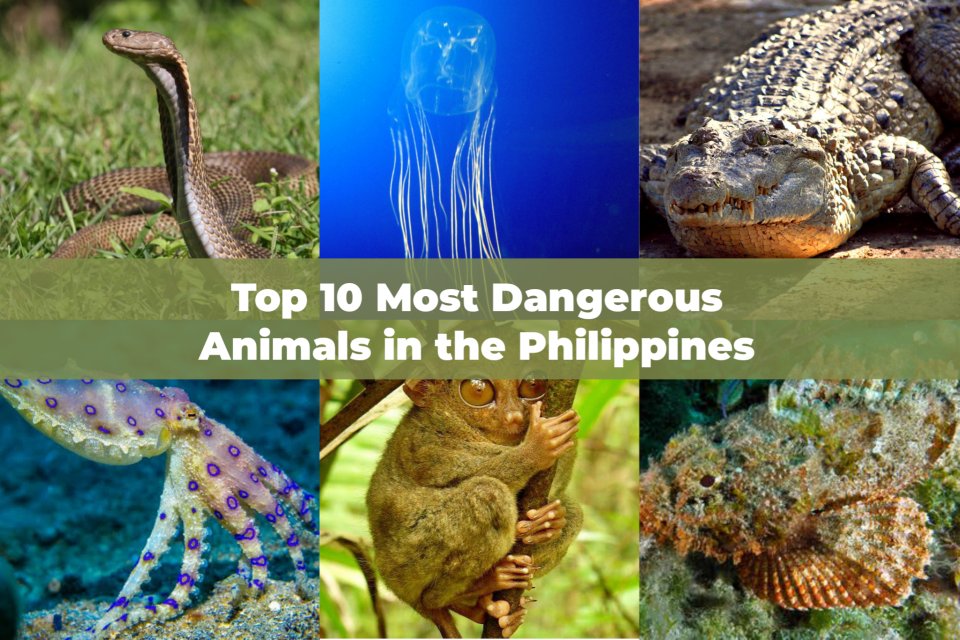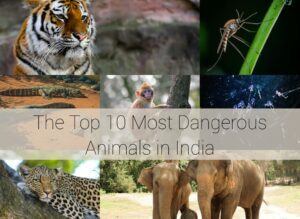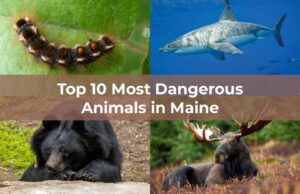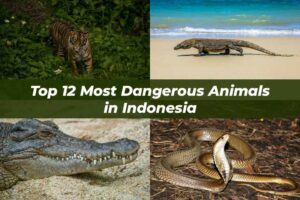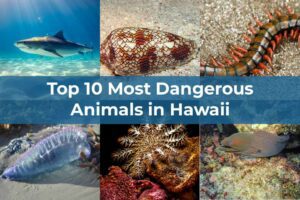When it comes to wildlife, the Philippines has its share of venomous or poisonous animals. Although the country does not have many large animals like some African countries, there are still some wildlife that is considered dangerous.
The Philippines is one of the most popular countries in Southeast Asia. It is famous for its lush rainforests and marine life.
In this article, we will look at the top 10 most dangerous animals in the Philippines.
The Top 10 Most Dangerous Animals in the Philippines
1. Philippine Cobra

Scientific name: Naja philippinensis
The Philippine Cobra, also known as the Philippine Spitting Cobra or Northern Philippine Cobra, is one of the most venomous snakes in the world.
These venomous snakes are mostly found throughout the northern regions of the Philippines. Some of the places where these snakes live are on the islands of Luzon, Mindoro, Catanduanes, and Masbate.
The venom from a Philippine cobra can cause paralysis, respiratory failure, and even loss of life within minutes. These cobras can also spit their venom at a target up to 3 meters (9.8 ft) away.
The best way to stay safe when you encounter a Philippine Cobra is to stay calm and keep your distance. I recommend leaving that area as soon as possible and informing someone.
2. Box Jellyfish

Scientific Name: Chironex fleckeri
Another dangerous animal in the Philippines is the Box Jellyfish. This jellyfish species is found in the waters around the country.
A Box Jellyfish delivers harmful venom through their tentacles when you come in contact with them. Their sting can be extremely painful and might lead to paralysis or even death.
Due to the appearance of these jellyfish species, they can be difficult to spot in the water. Box jellyfish can measure up to 20 cm (8 in) with tentacles that grow up to 3 m (10 ft) in length.
In the Philippines, box jellyfish are responsible for an estimated 20–40 deaths. This proves how dangerous their sting can be if left untreated.
The best way to protect yourself from box jellyfish stings is to wear full-body lycra suits, dive skins, or wetsuits. When swimming in open waters, also make sure to stick to designated areas and avoid swimming during jellyfish season.
3. Philippine Freshwater Crocodile

Scientific Name: Crocodylus mindorensis
Philippine Freshwater Crocodiles are also known as the Mindoro crocodile or the Philippine crocodile. These small crocodiles are found in rivers and marshes in the Philippines.
Philippine Crocodiles are found throughout some regions in the country, such as in the Northern Sierra Madre Natural Park within the Luzon rainforest, the Pulangi River in Bukidnon, Paghungawan Marsh in Siargao Island, the Ligawasan Marsh, Lake Sebu in South Cotabato, and a list of other places.
They cannot be found in places like Samar, Jolo, Negros, Masbate, and Busuanga.
Philippine Crocodiles can reach a maximum length of 3 meters (9.8 feet). On average, they can grow to about 2 meters (6.6 feet) long.
Just like any crocodile species, they have razor-sharp teeth, which can inflict serious injuries to even humans. Although Philippine Crocodiles look dangerous, they are not aggressive towards humans unless threatened or cornered.
When visiting the Philippines, avoid swimming in areas with multiple sightings of these crocodiles.
4. Bull Shark
Scientific Name: Carcharhinus leucas
Bull Sharks are another dangerous animal found in coastal waters around the Philippines. These sharks have the ability to live in both saltwater and freshwater environments.
What makes bull sharks dangerous? Well, they have a bite force of up to 5,914 newtons (1,330 lbf). This is more than enough to snap bones and tear off the flesh of prey.
Another reason is that they prefer to live in shallow waters near the shore, a trait that is unique compared to other sharks.
You can identify bull sharks from their appearance. They are grey on top and white below with a clearly visible dorsal fin.
Although bull sharks are capable of attacking humans, attacks in the Philippines do not happen often.
The best way to stay safe from these creatures is to avoid swimming in murky waters or near fishing boats. Do not also go swimming alone in open waters.
5. Blue-Ringed Octopus

Genus: Hapalochlaena
Blue-ringed octopuses are extremely venomous species of octopus that appear to be colourful in the water.
Their popular and unique yellowish skin and blue and black rings make them look beautiful as they change colour in the water.
Do not be deceived by their appearance; these creatures are very dangerous, and their venom contains a neurotoxin called tetrodotoxin.
What makes the blue-ringed octopus so fierce is that there is no available antivenom for someone who is bitten.
Bites from Blue-Ringed Octopuses are tiny and often painless. It might go unnoticed until symptoms like paralysis begin.
Other symptoms of their venom include nausea, respiratory arrest, heart failure, paralysis, blindness, and loss of life if left untreated.
Avoid approaching Blue-Ringed Octopuses when their blue rings are clearly visible. Do not go after them or touch them if they attempt to flee.
6. Banded Sea Krait
Scientific Name: Laticauda colubrina
Banded Sea Kraits are also known as yellow-lipped sea krait or colubrine sea krait. They are highly venomous snakes found in coral reefs and coastal areas around the Philippines.
This semiaquatic snake can be identified by their distinctive black stripes and yellow snout.
Banded Sea Kraits have a very poisonous neurotoxic venom that they use to hunt prey like eels and small fish. This venom can also be fatal to humans if bitten.
A bite from Banded Sea Kraits can cause severe pain, paralysis, and even loss of life.
Due to their semiaquatic nature, they can exist both in water and on land. Most of the time, they are found in the water intake and exhaust pipes of boats.
Banded Sea Kraits are also attracted to light, and sometimes this includes artificial sources of light from buildings.
Do not attempt to pick them up when you encounter them in the wild.
7. Samar Cobra

Scientific Name: Naja samarensis
Another dangerous snake in the Philippines is the Samar Cobra. This snake is highly venomous and native to the Visayas and Mindanao islands in the Philippines.
Samar Cobras are also known as Peters’ cobras, southern Philippine cobras, or Visayan cobras. They have unique colours varying from black and yellow to green.
This spitting cobra species can grow up to 1.4 meters in length. They can also spit their venom up to about 1.5 to 2 meters. This is 5 to 6.5 feet away.
Cobras are known to spit venom towards the face and eye, and this can be fatal. If you encounter a Samar Cobra in the wild, keep your distance and avoid making sudden movements.
8. Centipede
Scientific Name: Chilopoda
Centipedes are venomous arthropods that can inflict painful stings. Giant Centipedes such as the orange-legged centipede and the jungle centipede, are found throughout the Philippines.
A bite from these larger species of centipedes is usually very painful and can cause severe swelling, chills, fever, and weakness in adults and is more dangerous to small children.
In the Philippines, they are found in tropical forests, gardens, and even urban areas. Centipedes prefer to live in moist environments under rocks, logs, and leaf litter.
If you will be going into forest areas in the Philippines, make sure to wear strong boots and less revealing clothing.
9. Titan Triggerfish

Scientific Name: Balistoides viridescens
The Titan Triggerfish is also known as the giant triggerfish or moustache triggerfish. These Triggerfish species are found in coral reefs and are known for their aggressive behaviour towards divers and snorkelers.
Titan Triggerfish can cause serious injury underwater. Although their bites are not venomous, their strong teeth make the bite painful even to the extent of needing medical attention.
If you come across a Titan Triggerfish while swimming, swim horizontally away from them instead of upwards. This is because their territory extends upwards.
10. Philippine Tarsier

Scientific Name: Carlito syrichta
The Philippine tarsier is a small primate that is known as mawumag in the Philippines. They are found throughout the southeastern part of the archipelago, particularly on the islands of Bohol, Samar and Leyte.
Philippine Tarsiers are small and move around trees to avoid humans. From their looks, you will see that they are shy animals.
They are also nocturnal and mostly prefer to live a hidden life. They have adapted the ability to move from branch to branch easily.
Although Philippine Tarsiers are not poisonous or venomous, they can bite if they are threatened. Their bite can be painful and might cause infections.
It is best to observe them from a distance and avoid picking them up. Do not get excited and forget that they are wild animals.
Bonus
You have read the article to this point. I have prepared a bonus animal that is also considered dangerous in the Philippines.
Scorpionfish

Scientific Name: Scorpaenidae
Do not get confused. Scorpionfish are aquatic creatures that are different from the scorpions you already know.
Scorpionfish got their name from their ability to sting with sharp spines that contain venomous mucus, just like scorpions.
Scorpionfish are masters of camouflage, and they can blend with their surroundings, making them difficult to spot underwater.
Divers can accidentally touch their spines while underwear, and this can cause symptoms such as intense pain and severe poisoning.
Conclusion
The Philippines is a great travel destination for many travellers who are looking to explore some unique wildlife. In this article, we have provided a list of the top 10 most dangerous animals in the Philippines and a bonus.
Notice that most of these animals are aquatic; this is because the Philippines lacks large predators, unlike many other countries in Africa.
It is also important to understand that not all wildlife is dangerous, but humans might appear foreign to them, leading them to act aggressively.
I believe that the information in this article will be of help when visiting this country.
FAQs
Are there venomous animals in the Philippines?
Yes, venomous snakes are found throughout the Philippines. However, there are no native venomous spiders in the Philippines.
What animal is only found in the Philippines?
There are many animals that are only found in the Philippines. A few of them are the giant golden-crowned flying fox, Tamaraw, and Philippine Eagle.
What should I do if I get bitten by a snake?
If you are bitten by a snake, try to remember the snake’s appearance and seek medical help immediately. Properly identify the snake to the medical professional to receive the appropriate treatment.
Are there tigers in the Philippines?
No, there are no wild tigers in the Philippines. The country does not have big cats or large animals like elephants and rhinoceros.

Hi, I’m Louis Ojibe, and I grew up around wildlife in Africa. I have always been fascinated by animals and nature across the world.
As a child, my parents used to take me to see wild animals like lions, elephants, gorillas, tortoises, and many others at our local zoo.

